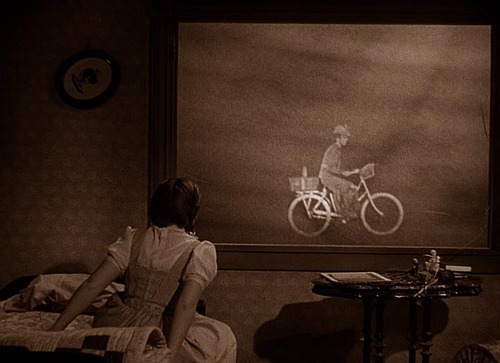
If there's a (horror) movie that seems to exist outside of film history it's the strange case of "The Wizard of Oz," newly released in a 70th anniversary package on DVD and Blu-ray. It's credited to director Victor Fleming, whose directorial stamp (if not his signature) was also emblazoned on another 1939 release, "Gone With the Wind." "Oz" is one of the first "scary movies" many boomer and post-boomer kids ever saw (even before exposure to the truly terrifying Disney versions of "Bambi" or "Dumbo" -- or, for today's kiddies, "Saw" and "Hostel" and "Irreversible"), and remains a formative childhood experience for millions. (Forget the flying monkeys; I was terrified by the tornado, then shocked and traumatized by the sadistic use of sarcasm, which I'd never encountered in a movie before, when the Wicked Witch mocks Dorothy's desperate cries for her surrogate mother: "Auntie Em! Auntie Em!") In a Newsweek interview, Dave Eggers (co-writer of Spike Jonze's film of Maurice Sendak's "Where the Wild Things Are") says that "Oz" is his daughter's favorite movie and that her favorite part is the bleak, sepia-toned beginning set in Kansas. Sendak responds:
That is so fascinating that she likes the beginning more than the rest of it, because the beginning is so scary. One, the sepia tone itself tells you to expect something stormy. The fact that they all unwittingly abandon her. Her aunt doesn't have time for her. Bert Lahr [the farm hand who reappears as the Cowardly Lion] doesn't have time for her. No one has time for her. And her being alone, even for that brief time--how terrifying that must be for her. It surely was for me. [...]
I've always had a private theory that when she gets home and she's in bed, and Frank Morgan [the Wizard], at the window, says something like, "Is she all right?" And her uncle makes it clear that they might lose her. It goes by very quickly, but then she tries to tell them her adventure, she tries to tell them what it was like when she was in Oz, and her aunt says, "It's all right, Dorothy, just lie down." In truth, the grown-ups just don't want to hear her death fantasy. They don't want to think that Dorothy could be in so much trouble that she might not survive. And she lays back in bed and says, "There's no place like home." And there were people who were very critical of that--sentimental--but for me it was pure irony. There is no place like home. Where the hell else is she gonna go? It's the opposite of sentimental--it's the hard truth. Grown-ups are afraid for children. It's not children who are afraid. That movie is unbelievably great. (tip: Sheila O'Malley)
In his New York Times review of the new DVD set, Dave Kehr gets to the heart of what made "The Wizard of Oz" a touchstone for a few generations:
A box-office disappointment on its first theatrical release in August 1939,¹ "The Wizard of Oz" assumed its place in American culture (and our collective subconscious) primarily through the annual holiday television broadcasts that began in 1956. The aura of specialness that attended those broadcasts -- here was a spectacle that could only be glimpsed once a year -- can never be recaptured in our age of media ubiquity and on-demand access, which makes it doubtful that the film will seem as personally meaningful to future generations as it does to the baby boomers who grew up with it.
For those who did, "The Wizard of Oz" remains among the most Proustian of movies, triggering waves of involuntary memories with each viewing. If there ever was a film that truly lies beyond criticism, "The Wizard of Oz" may well be it: for every viewer it is a different experience, layered with emotions and associations built up over the years.
Frank Capra's "It's a Wonderful Life" went through a similar process -- a commercial flop that was largely forgotten until it became an annual holiday ritual on television (after it passed into the public domain). Are there more recent forgotten films that are, or may become, rites of childhood for you or kids you know?
* * * *
¹ From Aljean Harmetz's "The Making of the Wizard of Oz" (1977):
The picture... opened well in the thirty-two key cities surveyed by Variety, bringing in more money the first week than such recently successful MGM films as "Goodbye, Mr. Chips" and "Idiot's Delight." But the picture didn't have firm enough legs to justify its cost. Part of the problem was the fact that nearly half of a typical audience for the picture consisted of children, who got in for reduced prices, so that even when the picture played to full houses, the theater made considerably less money than usual. Arthur Freed's "Babes in Arms," which was released two months after "The Wizard of Oz," cost $748,000 and grossed $3,335,000 for the studio. "The Wizard of Oz" cost $2,777,000 and grossed $3,017,000. When the costs of distribution, prints, and advertising were added to the cost of making "The Wizard of Oz," it meant a loss to the studio of nearly a million dollars. The movie edged into the black during its first re-release in 1948-49, when it brought in another $1,500,000; but it did not really make money until it was leased to television.





